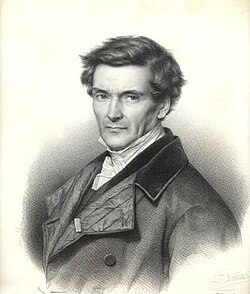Gaspard-Gustave Coriolis
| Gaspard-Gustave de Coriolis | |
|---|---|

Gaspard-Gustave de Coriolis
|
|
| Born |
21 May 1792 Paris, France |
| Died |
19 September 1843 (aged 51) Paris, France |
| Nationality | French |
| Fields | Mathematics, Physics |
| Institutions |
École Centrale Paris École Nationale des Ponts et Chaussées École Polytechnique |
| Alma mater | École Polytechnique |
| Known for | Coriolis effect |
(Gaspard-)Gustave de Coriolis (French: [ɡaspaʁ ɡystav də kɔʁjɔlis]; 21 May 1792 – 19 September 1843) was a French mathematician, mechanical engineer and scientist. He is best known for his work on the supplementary forces that are detected in a rotating frame of reference, leading to the Coriolis effect. He was the first to coin the term "work" for the transfer of energy by a force acting through a distance.
Coriolis was born in Paris in 1792. In 1808 he sat the entrance exam and was placed second of all the students entering that year, and in 1816, he became a tutor at the École Polytechnique, where he did experiments on friction and hydraulics.
In 1829, Coriolis published a textbook, Calcul de l'Effet des Machines ("Calculation of the Effect of Machines"), which presented mechanics in a way that could readily be applied by industry. In this period, the correct expression for kinetic energy, ½mv2, and its relation to mechanical work, became established.
During the following years, Coriolis worked to extend the notions of kinetic energy and work to rotating systems. The first of his papers, Sur le principe des forces vives dans les mouvements relatifs des machines (On the principle of kinetic energy in the relative motion in machines), was read to the Académie des Sciences (Coriolis 1832). Three years later came the paper that would make his name famous, Sur les équations du mouvement relatif des systèmes de corps (On the equations of relative motion of a system of bodies). Coriolis's papers do not deal with the atmosphere or even the rotation of the Earth, but with the transfer of energy in rotating systems like waterwheels. Coriolis discussed the supplementary forces that are detected in a rotating frame of reference and he divided these forces into two categories. The second category contained the force that would eventually bear his name. A detailed discussion may be found in Dugas.
...
Wikipedia
